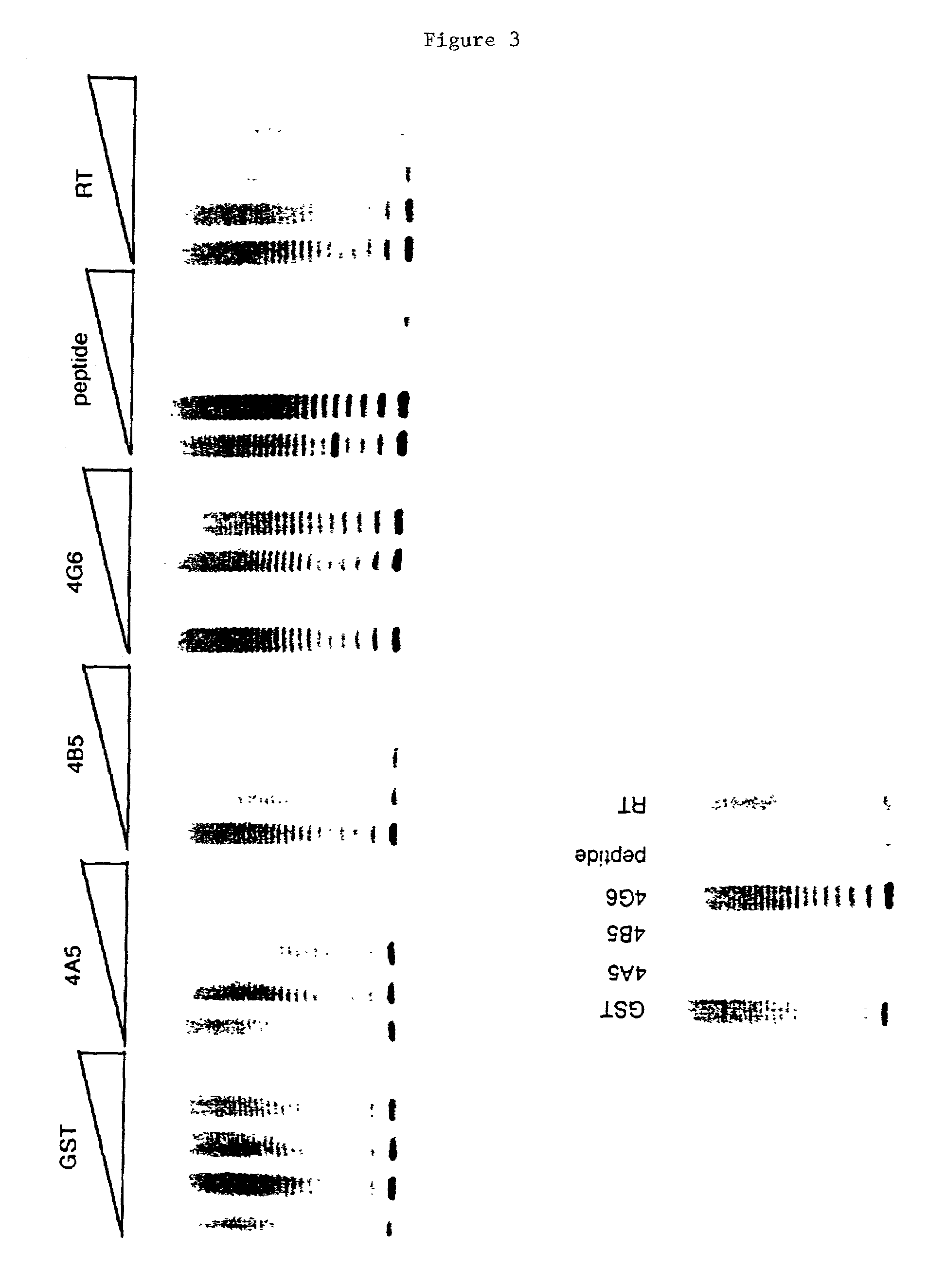Selective binding agents of telomerase
a technology of telomerase and binding agent, which is applied in the field of antibodies, can solve the problems of cell death, cell death, cell death and in some cases loss of tumorigenic phenotype, and achieve the effect of enhancing therapeutic effects and inhibiting telomerase activity
- Summary
- Abstract
- Description
- Claims
- Application Information
AI Technical Summary
Benefits of technology
Problems solved by technology
Method used
Image
Examples
example 1
Immunization of BALB / c Mice
[0114]A group of 5 mice were initially immunized with the TERT peptide (SEAEVRQHREARPALLTSRLRFIPKC; SEQ ID NO: 10; denoted herein as “TP2 peptide”) conjugated to keyhole-limpet hemocyanin (KHL). The TERT peptide corresponds to residues 602 to 616 of the catalytic subunit of human telomerase. The mice were bled from the tail every 10 days and the sera was diluted 1:500 in phosphate buffer saline (PBS). The response of the mouse to the antigen was measured by Western blots.
[0115]Full length hTERT was produced via in vitro translation using the Promega TNT (transcription and translation) T7 Reticulocyte Lysate System according to the manufacturer's instructions. hTERT was cloned into pCR vector as described in Harrington et al., Genes Del., 11: 3109–15 [1997] and Beattie et al., Curr Biol. 8: 177–80 [1997] and plasmid DNA was isolated using standard techniques. Each TNT reaction contained: 1 μg of hTERT plasmid DNA mixed with 50% TNT Rabbit Reticulocyte Lysat...
example 2
Hybridoma Production
[0119]To produce hybridomas secreting antibodies to hTERT, myeloma cells were fused with splenocytes from mice immunized with the TP2 peptide as described in Example 1. According to the method described in Kohler and Milstein (Nature 256: 495–497 [1975]).
[0120]Prior to fusion, the parental myeloma cell line (sp2 / 0, BALB / c origin; ATCC No. CRL 1581) was grown in Clonacell HY pre-fusion medium (MediumA) (StemCell Technologies, Vancouver, B.C.) for at least one week to ensure that the cells were well adapted. The sp2 / 0 myeloma cells were counted at the time of mid log phase growth and 2×107 viable cells were resuspended in 30 ml Medium A. Viability was determined by trypan blue exclusion.
[0121]To obtain the splenocytes for fusion, the immunized (mice nos. 2 and 4) were sacrificed and their spleens dissected. Initially, the sacrificed mouse's fur was washed with 95% ethanol and the chest cavity opened with sterile instruments. The lung and heart were cut first, then ...
example 3
Screening of Hybridoma Cultures
[0128]Selection of the hybridoma clones was carried out by testing the hybridoma culture supernanants for antibody production. Dot blot analysis was performed on the hybridoma supernatants, and mouse antibodies were detected with a sheep anti-mouse Ig horse radish peroxidase linked F(ab′)2 fragment (Amersham-Pharmacia Biotech). Four hundred clones were tested by dot blot and 104 clones tested positive.
[0129]Antibody production in these 104 clones was verified by the ability of the antibodies produced to detect the TP2 peptide on a Western blot. Human TERT was produced by the TNT reaction on rabbit reticulocyte lysates and immunoprecipitated as described in Example 1. Purified hTERT-RT (100 ng) was run on a 4–12% TRIS-glycine gradient gel (Novex) and transferred to a Immobilon-P membrane (Millipore). Broad range pre-stained protein standards (Biorad) were used as molecular weight markers. The membranes were probed with hybridoma superntants and an appro...
PUM
| Property | Measurement | Unit |
|---|---|---|
| Selectivity | aaaaa | aaaaa |
Abstract
Description
Claims
Application Information
 Login to View More
Login to View More - R&D
- Intellectual Property
- Life Sciences
- Materials
- Tech Scout
- Unparalleled Data Quality
- Higher Quality Content
- 60% Fewer Hallucinations
Browse by: Latest US Patents, China's latest patents, Technical Efficacy Thesaurus, Application Domain, Technology Topic, Popular Technical Reports.
© 2025 PatSnap. All rights reserved.Legal|Privacy policy|Modern Slavery Act Transparency Statement|Sitemap|About US| Contact US: help@patsnap.com



